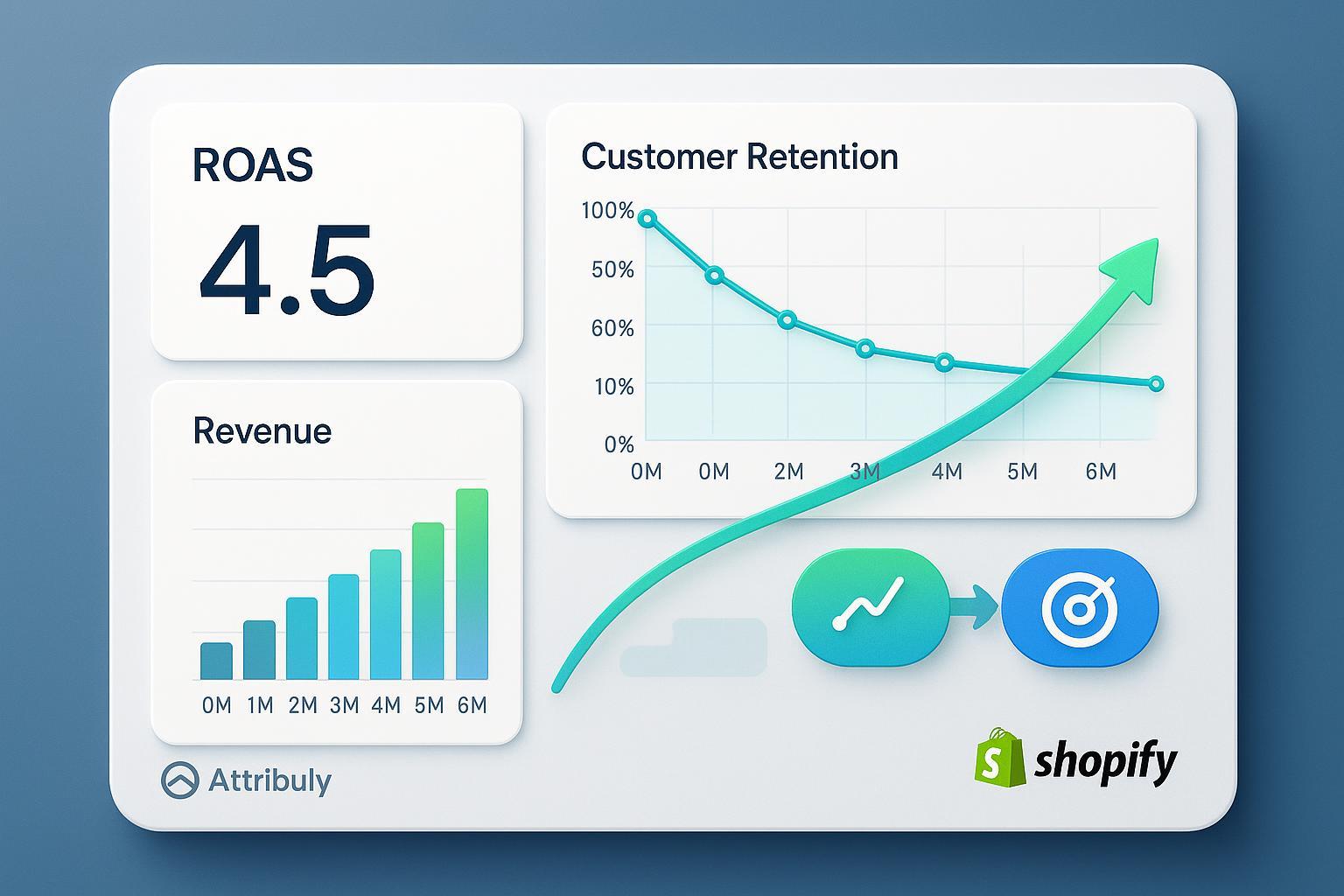How Balancing ROAS and Customer Retention Can Drive Sustainable Growth in E-Commerce (2025)

The Practitioner's Dilemma: ROAS Obsession vs. Sustainable Growth
If you’ve ever sat in a weekly marketing review, you know the drill: everyone’s eyes are glued to Return on Ad Spend (ROAS) dashboards. The higher the better, right? But here’s the rub—chasing short-term ROAS can be a dangerous game for e-commerce brands, especially in 2025. Acquisition costs keep climbing, platforms keep tweaking attribution, and customer expectations have never been higher. Sustainable growth isn’t just about winning the first sale; it’s about stacking repeat revenue, loyalty, and lifetime value (LTV).
From experience—having launched, scaled, and optimized Shopify brands—I've found the marketers who break out of the ROAS echo chamber are the ones who truly drive long-term profitability. In this article, let’s walk through how to balance ROAS and customer retention practically, blending foundational and advanced strategies. You’ll see why the most successful DTC brands in 2025 are using unified analytics and attribution platforms like Attribuly to turn what used to be a trade-off into real, measurable synergy.
Why ROAS Alone Fails in 2025: A Data-Driven Reality Check
Rising Acquisition Costs & Platform Benchmarks
- Industry benchmark for a “good” ROAS: In 2025, the broad target is 4:1 or higher, but this varies. Meta averages ~2.2x, Google Ads 4.5x, TikTok 1.4x, and e-commerce overall hovers around 2.9x (TCF Team).
- Blended ROAS (all channels) and MER (Marketing Efficiency Ratio) are increasingly preferred over last-click or channel-locked approaches. High-performing brands often exceed 5x blended ROAS, but that’s only part of the story.
ROAS Segmentation: Acquisition vs. Retention Campaigns
- Acquisition ROAS: Needs to cover Customer Acquisition Cost (CAC), typically aiming for 4x–5x to stay profitable with new audiences
- Retention ROAS: Profitable at lower thresholds (2x–3x), because repeat buyers cost less to re-engage and have higher LTV
- Leading practice: Track these separately and then pool them for a true blended ROAS
Pitfall to Dodge
Many brands measure all campaigns identically—ignoring that email, loyalty, and win-back flows work under a completely different ROI equation than new customer ad spend. Treating them as apples-to-apples leaves revenue on the table and risks over-spending on acquisition.
The Untapped Power of Retention in Driving Sustainable Growth
2025 Retention Tactics That Work
Based on what works across dozens of Shopify and DTC engagements, here’s what’s delivering tangible retention lifts:
- Customer Data Unification: Connect inventory, CRM, web analytics, and channel data for a 360º customer view (Shopify Retention Guide).
- Segmentation + Personalization: Use automated flows for onboarding, post-purchase check-ins, and anniversary offers. Email/SMS triggered by real-time activity drive 20%+ repeat rate lifts (Nector.io, 2025 DTC Trends).
- Subscription + Loyalty: Subscription programs now boost repeat purchase rates by 20%+ and LTV by up to 40%. Tiered loyalty drives AOV up by 21% (GetRecharge).
- Omnichannel Automation: Triggered campaigns across email, SMS, and social using unified attribution data—this is where platforms like Attribuly excel by connecting real-time signals with appropriate offer timing.
Benchmarks to Aim For
- 7.8% retention among older demos; 3.5% among younger, with room for improvement via automation
- Automated retention flows increase open and repeat purchase rates by 20%+
Practical Application: Attribuly in Retention Automation
Attribuly enables marketers to automate triggered campaigns (emails/SMS), segment audiences using identity resolution, and track incremental revenue generated by every touchpoint. The result: not only do retention campaigns become self-optimizing, but every win-back, cross-sell, or loyalty nudge is tied to actionable ROI.
The Unified Measurement Framework: ROAS, Payback, LTV & Retention ROI
From Metrics Silo to Holistic Growth Blueprint
Most brands still run their acquisition and retention analytics in parallel silos—sometimes on separate dashboards. In 2025, winning teams unify their reporting, mapping every vital metric:
| Metric Focus | Objective | Actionable Tactics | Outcome |
|---|---|---|---|
| ROAS | Immediate ad efficiency | Refine targeting/creative, optimize landing | Efficient acquisition |
| Payback Period | Faster recovery of spend | CAC/revenue tracking, funnel speed optimization | Faster cash flow |
| LTV | Higher value per customer | Upsell/cross-sell, retention flows, loyalty | More revenue per user |
| Retention ROI | Boost loyalty and repeats | Automated campaigns, reduce churn | Sustainable growth |
Implementing a Unified View with Attribuly
Attribuly’s integrated dashboards stitch together all campaign and journey data—Shopify orders, email/SMS engagements, paid impression/clicks, and even anonymous visitor insights via server-side tracking. You can:
- View acquisition vs. retention ROAS side-by-side
- Calculate payback period at cohort/segment/offer levels
- Visualize LTV growth across automation workflows
- Spot hidden high-ROI retention segments not visible in native ad tools
Case Scenario: DTC Wellness Brand
A DTC wellness client unified GA4, Shopify, and paid channel data through Attribuly, discovering that their email win-back flows were delivering a 22% higher retention ROAS than paid retargeting. By automating budget adjustments and personalizing segments, repeat purchase rates jumped +25%, and blended LTV rose by 30%—results backed by Attribuly’s proprietary impact reporting (Attribuly Case Data).
Attribution Model Evolution: The Shift to Multi-Touch for Smarter Decisions
Last-Click Attribution: Why It’s Outdated
Last-click attribution credits only the final touch before purchase, leaving nurturing touchpoints undervalued. In practice, email/sms, paid social, organic content, and even loyalty triggers all contribute along the customer journey.
Multi-Touch Attribution: The 2025 Gold Standard
Multi-touch attribution (MTA), especially when powered by identity resolution and real-time analytics, distributes credit across all campaign steps:
- Brands adopting MTA report ~12% better retention and 20% more new customers vs. last-click (OWOX Attribution Models).
- Attribution platforms (Attribuly, Saras, Northbeam) enable real-time budget reallocation when new high-ROI sequences are identified.
Attribuly in Action
Attribuly’s multi-touch model attributes value to every engagement—ad, email, social, even offline. Its AI analytics assistant visualizes payback period, LTV, and retention lift in real time. Crucially, this lets brands:
- Stop over-spending on initial clicks
- Invest confidently in retention channels proven to drive long-term value
- Surface under-reported but high-impact touchpoints (e.g., abandoned cart SMS)
Common Pitfalls, Trade-Offs, and What Actually Works
Pitfalls to Avoid
- Last-click bias: Under-investing in influence channels (email, loyalty, content)
- Retention neglect: Overspending on prospecting, underutilizing proven win-back sequences
- Siloed reporting: Fragmented data leading to misaligned budgets and missed growth opportunities
- Over-complex frameworks: Drowning in vanity metrics, losing actionable insights
Key Trade-Offs
- Complexity vs. ROI: Multi-touch and blended metrics mean more reporting sophistication. The payoff: far more actionable, long-term growth decisions.
- Short-term ROAS vs. Lifetime Value: High ROAS on acquisition is great—but investing in retention often yields higher profit over time, even if immediate ROAS dips. Success in 2025 is about finding that equilibrium based on your brand’s stage and goals.
- Automation vs. Human Touch: Automated flows can drive scale, but personalize your top retention paths—balance efficiency with experience.
Implement Tomorrow: The Hands-On Best Practice Checklist
- Benchmark ROAS for Acquisition vs. Retention: Don’t keep a single ROAS score—track campaign types separately and measure blended outcomes.
- Install Multi-Touch Attribution: Platforms like Attribuly offer code-free deployment for Shopify and major ad channels. Start attributing credit to influence and retention flows today.
- Set SMART Growth Goals: Integrate both short-term metrics (ROAS, payback period) and long-term ones (LTV, retention ROI).
- Automate Retention Campaigns: Use identity signals, triggered emails/SMS, and loyalty workflows—and monitor incremental revenue every week.
- Unify Reporting Dashboards: Connect your ad, email, CRM, and commerce data. If you’re not seeing full-funnel attribution in one place, ask why.
- Reallocate Budgets Monthly: Use analytics to spot emerging high-ROI retention segments and adjust spend.
- Iterate, Test, Learn: Retention and attribution models will keep evolving; set aside monthly time to review, test, and tune campaigns.
Practice-Based Perspective: Where Do You Start?
Having run these playbooks hands-on—across Shopify stores, DTC startups, and established e-commerce brands—the transition from ROAS silos to unified, retention-driven frameworks isn’t always seamless. Start with what’s easy: automate your first triggered win-back, segment retention vs. acquisition campaigns, and implement multi-touch reporting. With a platform like Attribuly, the friction drops, insights deepen, and the ROI compounds—especially when you connect all your traffic, identity, and revenue data sources.
Final Thought: Agility Is the New Best Practice
What works this quarter might be surpassed by new technology tomorrow. E-commerce analytics, attribution, and retention tactics are evolving—keep your workflow agile, your teams cross-trained, and your tech stack current. The brands that balance ROAS and retention with thoughtful, data-backed decisions will outlast the fads and own sustainable growth in 2025.
Ready to drive real growth? Discover how Attribuly powers multi-touch attribution, unified retention automation, and actionable Shopify analytics: Attribuly Product Overview →
